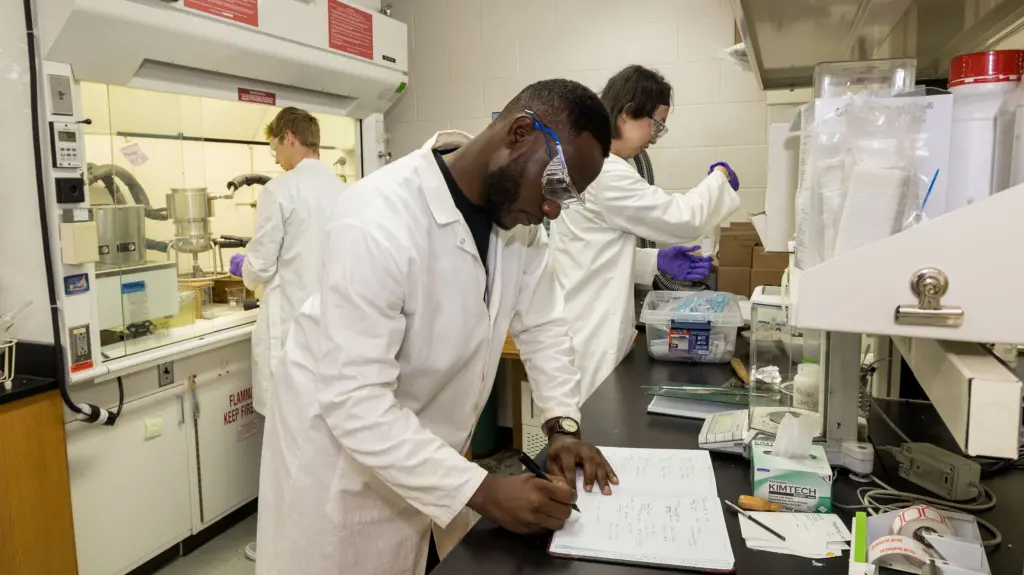Take a stroll through a grocery store and one thing is clear—almost everything, from meat and bread to produce and cookies—is packaged in some form of plastic. While those wrappers look simple, the plastic is much more sophisticated than it seems: Most of it is constructed from multiple layers, each with its own function—such as moisture-proofing, gas-permeability, oxygen-resistance or heat-tolerance.
While that makes the packaging great at preserving food, mixed plastic layers are incredibly difficult to recycle. Add in inks and dyes and recycling gets even more complicated. Developed by University of Wisconsin-Madison chemical engineers, a process called solvent-targeted recovery and precipitation, or STRAP, uses a solvent to dissolve the plastic in each layer, allowing them to recover plastic resins one by one.
Several labs in the Department of Chemical and Biological Engineering at UW-Madison are now collaborating on STRAP research through the Department of Energy-funded Center for Chemical Upcycling of Waste Plastics. Now, several graduate students and postdoctoral researchers have begun to bring STRAP much closer to a commercial reality.
Panzheng Zhou, a PhD student working in the lab of Hunt-Hougen Associate Professor Reid Van Lehn, PhD students Kevin Sánchez-Rivera and Charles Granger and postdoctoral researchers Jiuling Yu, Euncheol Ra and Tianwei Yan from the lab of Richard L. Antoine Professor George Huber, postdoctoral researcher Aurora Munguía-López, from the lab of Baldovin-DaPra Professor Victor Zavala, and PhD student Ugo Ikegwu, co-advised by Van Lehn and Zavala, have all collaborated on several recent papers and are leading many new projects.
Zhou worked on ways to match the right solvent to the right plastic layer. “We need to find a suitable solvent system that dissolves our target plastic, but not the other components,” Zhou says. “This is challenging because the number of potential solvents is very large.”
He developed computational methods to predict the solubility of common polymers found in plastic packaging when exposed to solvents. Zhou created tools that make thermodynamic calculations for eight common polymers, or plastics, exposed to about 1,000 solvents at various temperatures. “With these tools, we could help select solvents that could do the recycling job and suggest the operational temperature of the process,” he says.
 Graduate students Charles Granger, Ugochukwu Ikegwu and Kevin Sanchez Rivera are working on new ways to recycle multi-layer films using solvents. Credit: Joel Hallberg.
Graduate students Charles Granger, Ugochukwu Ikegwu and Kevin Sanchez Rivera are working on new ways to recycle multi-layer films using solvents. Credit: Joel Hallberg.
Zhou, Yu and Sánchez-Rivera also conducted experiments to see if their analysis was correct—finding that indeed the solvents identified did dissolve the target films. Now, their database will allow researchers to choose the right solvents for each plastic layer in the STRAP process.
Led by Yu, a team of researchers looked into STRAP as a way to combat face mask waste. During the height of the COVID-19 pandemic, the world was using 129 billion disposable face masks per month, creating a huge new stream of waste. These masks are made of several layers of plastics, including different types of polypropylene, while the ear loops are made of nylon, polyurethane and polyethylene terephthalate. Because of this mix of plastics, the masks were considered non-recyclable.
The team shredded the masks and used a solvent to remove the polypropylene from the mix. This allowed them to recover about 90% of the plastic resin by weight. They then used a chemical to remove the blue color from the resin, leaving behind high-quality polypropylene with properties and color close to virgin resin.
While the need for masks has waned, the project demonstrates the recyclability of these and other types of personal protective gear that previously went to the landfill.
Sánchez-Rivera, Munguía-López, Zhou and Yu also demonstrated how STRAP can be used to recycle printed multilayer films. Inks are one of the major hurdles for STRAP, since they can complicate the recycling process.
The team first used gamma-valerolactone, a chemical derived from agricultural waste through an environmentally friendly chemical production method, to remove the polyurethane-based ink from food packaging. Once the ink was gone, the team could apply STRAP to dissolve each layer of plastic using a specific solvent and reduce the packaging to virgin resins.
According to economic analysis of the process, it is possible to use STRAP to recycle 6,000 tons of printed multilayer packaging per year, with lower emissions than producing virgin plastic.
Van Lehn says the projects are validating the STRAP technology and expanding its potential. Currently, STRAP is best suited for post-industrial waste, or the leftover multilayer film scraps produced when packaging is manufactured. Previously, that waste was landfilled, but STRAP makes it possible to recycle. “We know exactly what goes into this material. And the volumes are already large enough for recycling the scrap to be profitable at scale,” says Van Lehn. “So it’s kind of the low-hanging fruit.”
These latest projects are showing that, with the right tuning, STRAP could also be applied to post-consumer plastic—the enormous amounts of packaging we currently toss in the garbage.
Zhou says collaborating with other students and labs has accelerated and improved everyone’s work. “Doing computational research, I would like to work on something that leads to a real-world application,” he says. “So having experimental collaborators that I can help find solutions makes me feel my work has value. This will have a real impact on so many of us.”
Top image caption: Students and postdoctoral fellows are researching innovations in STRAP recycling, a process pioneered at UW-Madison. From left to right, PhD students Charles Granger, Kevin Sánchez-Rivera and Panzheng Zhou and postdoctoral researcher Tianwei Yan. Credit: Joel Hallberg.